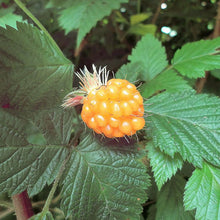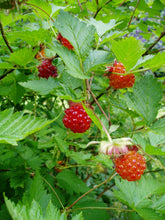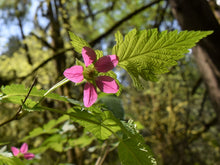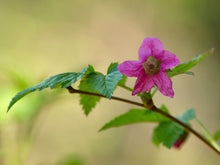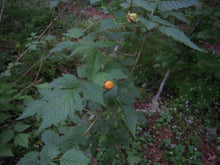
Rubus spectabilis
Salmonberry is a large deciduous shrub with magenta, star-shaped flowers that attract and support rufous hummingbirds on their return migration, along with other pollinators. In early summer, pollinated flowers become salmon-colored fruits that resemble raspberries and are edible to humans and wildlife, though not particularly delicious. Its upright, arching stems are thicket-forming over time, but less prickly than other natives with a similar habit.
- Plant type/canopy layer: large deciduous perennial shrub
- Size at maturity: 4-12' tall, 4-10' wide, thicket-forming over time
- Light requirements: full sun to full shade
- Moisture requirements: moist to wet soil
- Bloom time: March - June (March - April in Portland-metro area)
- Growth rate/ease: fast growing, easy to grow
- Wildlife support: flowers attract and provide an early season source of nectar to hummingbirds, bees and other insect pollinators; berries are food for wildlife especially birds such as grouse, pigeons, quail, grosbeaks, jays, robins, thrushes, towhees, waxwings, sparrows and mammals such as raccoons, opossums, skunks, foxes, squirrels, chipmunks and bears; leaves/stems are eaten extensively by deer, elk and rabbits; overall plant is a caterpillar host plant and food source for native butterfly and moth larva and eaten by bear, beaver and marmots; thickets provide essential cover and refuge for countless species of birds and mammals
- Native habitat/range: locally common in moist forests, along the coast, and stream margins, especially in the coastal forests and often thriving in the open spaces under stands of Red Alder, from sea level to about 1800m, from southern Alaska to northern California. Portland Plant List - yes.
- Special features & uses: showy flowers that attract and support hummingbirds; many landscape uses including pollinator gardens, raingardens and woodland gardens, erosion control and habitat-hedgerows; edible berries that can be made into jams, jellies, candy, or wine, traditionally indigenous people eat the berries in oolichan grease or with salmon or salmon eggs, young sprouts can be peeled and eaten raw or steamed like asparagus; medicinally uses include preparations of the bark for burns and other wounds and to treat diarrhea
Gardening with Salmonberry: Salmonberry is happiest in areas with dappled shade and moist to wet soil. That said, a “happy” salmonberry is quickly spreading and colonizing large areas into habitat-friendly thickets. Drier soil can help slow the spread of this aggressive plant. It is extremely effective at bank stabilization and erosion control, making it an ideal option for riparian restoration projects and larger, wild areas in the habitat garden.
Photo Credit 1: "File:Salmonberry Blossom.jpg" by Überraschungsbilder is licensed under CC BY-SA 3.0
Photo Credit 2: "Salmonberry" by catalex7 is licensed under CC BY 2.0
Photo Credit 3: "File:Salmonberry, Rubus spectabilis.JPG" by Jrtayloriv is licensed under CC BY-SA 3.0
Photo Credit 4: Nikkie West, Sparrowhawk Native Plants





